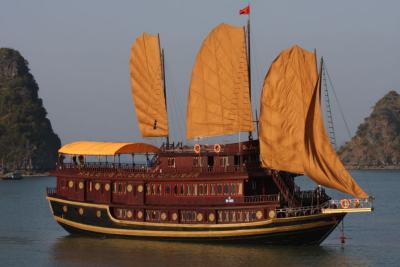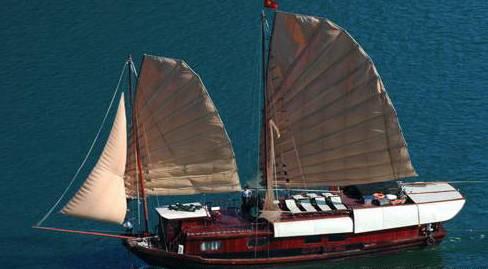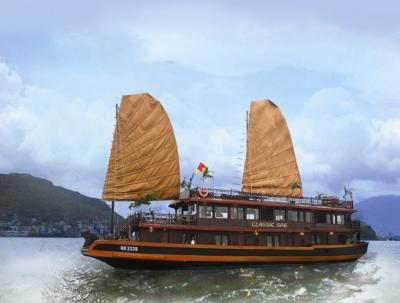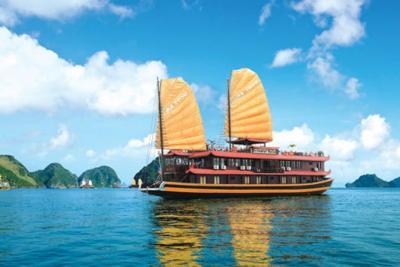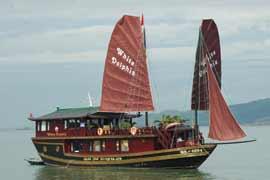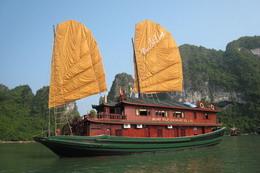Lam Kinh Back to origins of the later Le Dynasty
Published: 06/03/2013 04:10
After enthronement, hero Le Loi, the leader of the Lam Son Insurrection, started the feudal Le Dynasty. To commemorate his homeland and also the revolutionary base of the Lam Son Insurrection, a monument was built in the sacred land of Lam Son, called Lam Kinh today
The Lam Kinh historical vestige is located in Xuan Lam, Tho Xuan, Thanh Hoa province, about 50km from the city of Thanh Hoa in the northwest. The Lam Kinh historical vestige covers about 200ha, including royal tombs, temples, ramparts and royal stop-over places of the Le dynasty. This historical place was recognized as a national historical monument in 1962. Lam Kinh architecture Lam Kinh was built based on the theory of fengshui, which can be seen in its aspects and arrangement of the whole architecture. This arrangement that relied on the geographical condition and advantages of the nature is very harmonious. The main hall had the Chu River in front, flowing from the west to the east. From the center of the Lam Kinh Temple, to the southwest, we can see the Muc Son Mountain, next to the right bank of the Chu River,to the southeast, the Chu Mountain in the Chu River left bank. In the east stand the Phu Lam Forest and the Ngoc Mountain to create the left blue dragon; in the west are the Huong and Ham Rong mountains to create the right white tiger. From behind (the north) is the Dau Mountain playing a role as the protector. Forests and mountains in this sacred land with extraordinary people are magnificent and exotic. According to history and archaeology, the structure and architecture of the Lam Kinh Temple was once splendid. The Lam Kinh Temple was built according to the east-west axis with the length of 314m, the width of 254m and the thickness of 1m with the southern gate. Passing through the gate about 10m, one can see the Ngoc River around the temple with the White Bridge crossing it. About 50m from the bridge, the ancient Pearl Well sits in front of the Nghi Mon Gate to the left of the entrance. Nghi Mon is the gate to the Dragon Yard with three gates, in which the middle one is 3.5m wide; and the other two have the width of 2.7m. The gate is guarded by two stone lions. The Dragon Yard extends the width of the chamber. The Dragon veranda floor has three paths, of which the middle one is 1.8m wide and the other two are 1.2m. Dragons on the middle path are carved with the body winding and patterns of fires, a mane on the head and a curved beard. The dragons’ hands, which are the same as human’s ones, holding their beard. Dragons on the edges have the shape of stylized clouds. The ground of the temple is 1.8m higher than the Dragon Yard. Quang Duc (in front with nine spaces), Sung Hieu (in the middle, four spaces) and Dien Khanh (on the back, nine spaces) temples were built in the gong shape. There are 22 spaces with total area of 1,650sq.m. On the back of Lam Kinh locates Cuu Mieu (nine temples) with the bow-shaped structure. This place was constructed to worship kings, queens and the royal family. In addition, a 50m wall, which was built on the back of the architecture, was the fence of the temple. This temple was the worship place, where the King from Dong Do celebrated all rituals while visiting. Outside the temple is the permanent apparatus that has the mission of protecting the temple. The Kings and Queens’ tombs are mostly gathered in the northeast of Lam Kinh temple. Le Thai To’s grave was built in the main path behind the temple. It is a pity that most of the Lam Kinh Temple was damaged. After 600 years with severe weather conditions and wars, the splendid architecture became ruins. Walls were broken; Nghi Mon was devastated; temples and Cuu Mieu (nine temples) also remain. Some structures have been repaired such as Ngoc bridge, Nghi Mon and Cuu Mieu. Some vestiges that can be seen today are the Dragon veranda floor. Remaining vestiges and permanent values Artistic values of the Lam Kinh Temple are also seen through remaining vestiges and materials, which were excavated by archaeologists although it was vastly damaged. Five graves of the Kings and one of the Queen Mother of the Le Dynasty were also found in the temple: Vinh Lang (the tomb of Le Thai To King), Huu Lang (the tomb of Le Thai Tong King), Chieu Lang (the tomb of Le Thanh Tong King), Khon Nguyen Chi Duc (the tomb of Queen Mother Ngo Thi Ngoc Dao, King Le Thanh Tong’s mother), Du Lang (the tomb of Le Hien Tong King) and Kinh Lang (the tomb of Le Tuc Tong King). Tombs of the Le Dynasty are well-located and plainly built. They include three main parts: steles in front of the tomb, two lines of stone statues and the tombs themselves. The tomb of Le Thai To King (Vinh Lang), situated behind the Lam Kinh Temple, is simple. Therefore, tombs of other Kings were also constructed modestly. One of untouched vestiges and the most valued in Lam Kinh is Vinh Lang. The stele is located in the southwest of Lam Kinh and made of monolithic sediment with the height of 2.97m, width of 1.94m and thickness of 0.27m. It is on the back of a big turtle, which is 3.46m length, 1.9m width and 0.94m height. Vinh Lang stele is sophisticatedly decorated with skillful sculptures. On it were carved five words – Lam Son Vinh Lang stele. A short and succinct epitaph, written by Nguyen Trai, on Vinh Lang summarizes the career and praises the merit of Le Thai To King. The present stele was rebuilt in 1961 in the Le Dynasty’s design. Lam Kinh is where hero Le Loi and many Kings and Queen Mothers of the later Le Dynasty lie at rest forever. Lam Kinh is the original point of the later Le Dynasty, the longest feudal reign in Vietnam (1428-1789). It is a place to worship the ancestors. Lam Kinh also manifests the indomitable spirit of the Lam Son Insurrection led by Le Loi. Vietnambreakingnews |
Provide by Vietnam Travel
Lam Kinh Back to origins of the later Le Dynasty - Vietnam Culture Value | vietnam travel company
You can see more
- “Sac bua” singing recognised as national intangible cultural heritage
- Market Culture in Vietnam
- Hung Kings worship, source of nation's strength
- Honoring Hung Kings’ worship rituals
- Forging craft of Nung ethnic people in Cao Bang
- Foreign tourists go to Vietnam to… eat, why not?
- Perfume Pagoda pilgrimage
- Culture in ethnic groups
enews & updates
Sign up to receive breaking news as well as receive other site updates!
- Banh Đa Cua - a traditional Hai Phong specialty
- Exploring Lai Chau cuisine
- Hanoi ranked top 3 cuisine in the world in 2023
- Beautiful resorts for a weekend escape close to Hanoi
- Travel trends in 2023
- In the spring, Moc Chau is covered in plum blossoms.
- The Most Wonderful Destinations In Sapa
- Top 3 Special festivals in Vietnam during Tet holiday - 2023
- 5 tourist hotspots expected to see a spike in visitors during Lunar New Year 2023
- How To Make Kitchen Cleaned
-
vietnam travel
http://www.vietnamtourism.org.vn " Vietnam Tourism: Vietnam Travel Guide, Culture, Travel, Entertainment, Guide, News, and...
-
Vietnam culture, culture travel
http://travel.org.vn " Vietnam culture
-
Vietnam travel, vietnam travel news, vietnam in photos
http://www.nccorp.vn " Vietnam travel, vietnam travel news, vietnam in photos
-
Vietnam tourism
http://www.vietnamtourism.org.vn " The official online information on culture, travel, entertainment, and including facts, maps,...
-
Vietnam Travel and Tourism
http://www.vietnamtourism.org.vn/ " Vietnam Travel, Entertainment, People, Agents, Company, Vietnam Tourism information.
-
Information travel online
http://www.travellive.org "Information travel online



